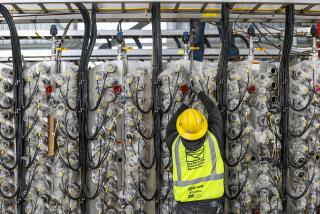Lockheed Unit to Manage $125-Million Water Cleanup : Environment: Taxpayers will pick up most of the bill. Critics say the Burbank aerospace firm will benefit from the pollution it caused.
- Share via
Lockheed Corp. has hired its own environmental services subsidiary to manage the multimillion-dollar cleanup--mostly at taxpayer expense--of Burbank ground water, generating criticism that Lockheed will benefit from the pollution it caused.
But executives of the aerospace company said Monday that Lockheed will not make a profit on the $125-million project, which will probably be paid for mainly by the Department of Defense.
A federal judge in Los Angeles cleared the way Monday for Lockheed to start work on the cleanup, which will involve continuous extraction and treatment of huge quantities of ground water for up to 20 years. Once purged of suspected cancer-causing solvents, most of the water will be piped to Burbank residents and the rest re-injected into the ground.
U. S. District Judge Mariana R. Pfaelzer approved a consent decree requiring Lockheed to design and build the treatment system in two years, then run it for the first six years. In its latest annual report, Lockheed estimated the cost of its eight-year involvement at $125 million--a big increase from its previous estimates of about $80 million.
Lockheed’s former Burbank production complex has been identified by state and federal environmental officials as a major source of solvents that have polluted ground water in Burbank, forcing the city to shut municipal water wells. The area has been designated for cleanup under the federal Superfund program, which requires those responsible for pollution to pay for cleanup.
However, Lockheed and Pentagon officials have signed a memorandum under which the Department of Defense tentatively agreed to reimburse most cleanup costs, less any money Lockheed is able to recover from insurance or from other polluters.
The government accounts for 85% of Lockheed’s business, and company officials say they expect to recoup that percentage of their cleanup costs from the government, billing it as an overhead cost to current and future government contracts.
They said they will try to recover the rest from commercial and foreign customers, who account for about 15% of their business.
The cleanup will be managed by Lockheed Engineering & Sciences Co., Lockheed’s entry in the growing environmental cleanup business. Although the Lockheed unit will subcontract some of the work, up to 20 members of its staff will be busy on the project for the next eight years, project manager Ron Helgerson said.
Lockheed spokesman Scott Hallman refused to estimate how much money the subsidiary will receive. He said, however, that Lockheed will charge the government only the cleanup expenses, with no profit margin added.
But critics said Lockheed will benefit anyway. And they claimed that the firm will have little incentive to control costs.
“The real problem comes from the fact that the taxpayer’s picking up the bill,” said Lenny Siegel of the National Toxics Campaign Fund, an environmental group. If Lockheed “had to pay the bill, as polluters should, then the problem would disappear.”
Others said the project will burnish Lockheed’s resume as it competes for lucrative cleanup contracts.
“Lockheed’s very much trying to get into the environmental business, so they will most certainly point to this as part of their new environmental expertise,” said Liz Galtney, director of the Project on Government Procurement, a Washington-based watchdog group involved in military and environmental issues.
“We’re definitely going to gain valuable experience doing this work, and I don’t think there’s anything wrong with that,” responded Hallman, the Lockheed spokesman.
Hallman also defended reimbursement of Lockheed’s costs, saying the firm had built military aircraft for decades to government specifications. “The argument that Lockheed is a bad guy just doesn’t hold,” he said.
Disclosure last year that the government--not Lockheed--will pay the bulk of cleanup costs created a minor sensation. Officials with the U. S. Environmental Protection Agency and the Justice Department--who boasted of the settlement they had negotiated with Lockheed--said at the time that they were unaware of the firm’s side agreement with the Pentagon.
“That’s wonderful to hear,” one federal official said sarcastically. “I think that Lockheed should have paid for the whole thing.”
However, EPA spokeswoman Lois Grunwald said Monday that it is “not our concern or business” who funds or manages Superfund cleanups. As long as Lockheed officials “carry out their responsibility and clean it up, then it’s not our concern where they get their money,” she said.
The Times reported in the fall that the Pentagon has paid environmental costs for a number of defense contractors besides Lockheed.
Two lawmakers in January asked the General Accounting Office to investigate the practice. In a letter to the GAO, Reps. Barbara Boxer (D-Greenbrae), who chairs the House Armed Services subcommittee on investigations, and John Conyers Jr. (D-Mich.), chairman of the House Government Operations Committee, said they wanted “to make certain that taxpayers do not foot the bill for a company’s transgressions by paying costs that should be borne by the polluter.” GAO officials have not concluded the inquiry.
The basis for repayment of cleanup costs is the Federal Acquisition Regulation, which allows federal agencies to reimburse costs that are “reasonable” and “ordinary and necessary to the conduct of the contractor’s business.” This has been interpreted by the Pentagon to include cleanup costs.
While saying he did not have specific figures, Hallman also disclosed Monday that the United States has reimbursed Lockheed for cleanup work at its former Burbank production complex, which Lockheed is getting in shape for sale.
Hallman said the work included inspection and removal of buried fuel and chemical storage tanks, cleanup of contaminated soil and the wholesale removal of an old landfill from the Lockheed property to a hazardous waste disposal site.
More to Read
Sign up for Essential California
The most important California stories and recommendations in your inbox every morning.
You may occasionally receive promotional content from the Los Angeles Times.













